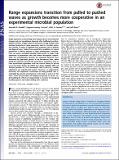Range expansions transition from pulled to pushed waves as growth becomes more cooperative in an experimental microbial population
Author(s)
Korolev, Kirill S.; Gandhi, Saurabh Rajendra; Yurtsev, Eugene; Gore, Jeff
DownloadGore_Range expansions.pdf (6.976Mb)
PUBLISHER_POLICY
Publisher Policy
Article is made available in accordance with the publisher's policy and may be subject to US copyright law. Please refer to the publisher's site for terms of use.
Terms of use
Metadata
Show full item recordAbstract
Range expansions are becoming more frequent due to environmental changes and rare long-distance dispersal, often facilitated by anthropogenic activities. Simple models in theoretical ecology explain many emergent properties of range expansions, such as a constant expansion velocity, in terms of organism-level properties such as growth and dispersal rates. Testing these quantitative predictions in natural populations is difficult because of large environmental variability. Here, we used a controlled microbial model system to study range expansions of populations with and without intraspecific cooperativity. For noncooperative growth, the expansion dynamics were dominated by population growth at the low-density front, which pulled the expansion forward. We found these expansions to be in close quantitative agreement with the classical theory of pulled waves by Fisher [Fisher RA (1937) Ann Eugen 7(4):355–369] and Skellam [Skellam JG (1951) Biometrika 38(1-2):196–218], suitably adapted to our experimental system. However, as cooperativity increased, the expansions transitioned to being pushed, that is, controlled by growth and dispersal in the bulk as well as in the front. Given the prevalence of cooperative growth in nature, understanding the effects of cooperativity is essential to managing invading species and understanding their evolution.
Date issued
2016-05Department
Massachusetts Institute of Technology. Department of PhysicsJournal
Proceedings of the National Academy of Sciences
Publisher
National Academy of Sciences (U.S.)
Citation
Gandhi, Saurabh R. et al. “Range Expansions Transition from Pulled to Pushed Waves as Growth Becomes More Cooperative in an Experimental Microbial Population.” Proceedings of the National Academy of Sciences 113.25 (2016): 6922–6927. © 2016 National Academy of Sciences
Version: Final published version
ISSN
0027-8424
1091-6490